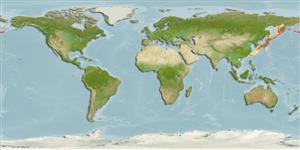Environment: milieu / climate zone / depth range / distribution range
Ecología
marino demersal; rango de profundidad 175 - 900 m (Ref. 50550), usually 400 - 600 m (Ref. 56390). Temperate
Northwest Pacific: off Hokkaido, Japan to the northern Sea of Okhotsk, Kuril Islands and Kamchatka
Tamaño / Peso / Age
Maturity: Lm ? range ? - ? cm
Max length : 15.6 cm TL macho / no sexado; (Ref. 56390); peso máximo publicado: 50.00 g (Ref. 56395); edad máxima reportada: 7 años (Ref. 56390)
Life cycle and mating behavior
Maturities | Reproducción | Spawnings | Egg(s) | Fecundities | Larva
Masuda, H., K. Amaoka, C. Araga, T. Uyeno and T. Yoshino, 1984. The fishes of the Japanese Archipelago. Vol. 1. Tokai University Press, Tokyo, Japan. 437 p. (text). (Ref. 559)
IUCN Red List Status (Ref. 130435)
Threat to humans
Harmless
Human uses
Pesquerías: sin interés
Herramientas
Special reports
Download XML
Fuentes de Internet
Estimates based on models
Preferred temperature (Ref.
123201): 0.3 - 3.6, mean 0.8 °C (based on 30 cells).
Phylogenetic diversity index (Ref.
82804): PD
50 = 0.5000 [Uniqueness, from 0.5 = low to 2.0 = high].
Bayesian length-weight: a=0.00676 (0.00300 - 0.01523), b=3.17 (2.98 - 3.36), in cm total length, based on LWR estimates for this (Sub)family-body shape (Ref.
93245).
Nivel trófico (Ref.
69278): 3.4 ±0.4 se; based on diet studies.
Generation time: 6.5 ( na - na) years. Estimated as median ln(3)/K based on 1
growth studies.
Resiliencia (Ref.
120179): Bajo, población duplicada en un tiempo mínimo de 4.5-14 años (Preliminary K or Fecundity.).
Fishing Vulnerability (Ref.
59153): Low vulnerability (10 of 100).
